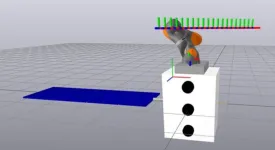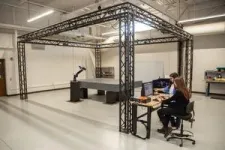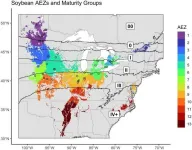(Press-News.org) SAN ANTONIO — April 9, 2024 — Southwest Research Institute has invested in new space robotics capabilities to help the space industry pave the way for in-space servicing, assembly and manufacturing (ISAM) capabilities. SwRI’s Intelligent Systems Division will demonstrate new ISAM-focused research at the 38th Space Symposium, April 8-11, in Colorado Springs. Visit SwRI at Booth #237.
“SwRI is developing solutions to leverage Earth-based industrial robotics with advanced automation and simulation so we can help clients develop new capabilities for the complex conditions of space,” said Meera Towler, an SwRI engineer who leads SwRI’s Space Robotics initiative.
The Space Symposium brings together leaders from around the world to discuss and plan for the future of space. Through ISAM, NASA and others envision a space industry with agile vehicles that will deploy parts and materials into space for robotic manufacturing and assembly. An important enabling step for ISAM includes developing Earth- and lunar-based test beds and even research facilities on the surface of the Moon.
SwRI’s space robotics research focuses on high-fidelity simulation, advanced perception, robotic manipulation in space and extraterrestrial automated driving. SwRI’s new Space Robotics Center supports this research with an air-bearing table, motion capture system, a seven degree-of-freedom robot arm, test fixtures and more.
Engineers developed software and modeling tools to help robots plan motion for complex, on-orbit conditions. SwRI is also developing efficient low-power vision for lunar rovers or small aerial systems.
“We are excited to share these R&D projects with the space community to help bridge the gap between today’s power-hungry, Earth-based industrial robots and the near-future ISAM ecosystem where advanced automation will help build the next generation of space infrastructure,” said Dr. Steve Dellenback, vice president of SwRI’s Intelligent Systems Division.
Space-Based Robot Motion Planning — SwRI used a physics-based simulation tool to develop a robotics simulation package to address challenges associated with object identification, trajectory tracking and dynamic motion planning in space. SwRI will evaluate the simulation models using a robot arm on an air-bearing table in the Space Robotics Center.
Localization for Lunar Rovers — SwRI investigated deploying its Ranger localization system on lunar rovers. Ranger’s ground-facing cameras and automation software successfully guided a rover across simulated regolith.
Camera Vision for Cave Exploration — SwRI used caves as testbeds to evaluate unmanned aerial systems (UAS) for future space applications. New algorithms successfully used stereo cameras to autonomously guide a small UAS.
Stereovision vs Lidar for Off-Road Autonomy — SwRI used a recurrent neural network (RNN) algorithm to estimate vehicle motion from a sequence of camera images, inertial measurements and wheel data for off-road navigation. As an alternative to lidar, the stereovision solution could provide simultaneous localization and mapping for extraterrestrial navigation.
FPGA Computing for Faster Object Detection — SwRI used a space-ready field programmable gate array (FPGA) to accelerate object detection. The solution leveraged an open-source algorithm deployed on a FPGA, which outperformed a commercially available solution and traditional space computers.
RISC-V/ARM for Faster Space Computing — SwRI is evaluating the next generation of fast, reliable microprocessors for embedded spaceflight systems. Some space-ready FPGAs outperformed conventional processors, and an Advanced RISC Machines (ARM) processor outperformed a legacy space processor, using a fraction of the energy.
SwRI’s Intelligent Systems Division is a leader in development of software, cybersecurity, artificial intelligence, data analytics and systems engineering solutions.
To watch a video about this research, visit: https://youtu.be/1nC8INMtng8.
For more information, visit https://spacerobotics.swri.org.
END
SwRI demonstrating robotics for in-space manufacturing at Space Symposium
Institute builds new Space Robotics Center for in-space servicing, assembly, manufacturing R&D
2024-04-09
ELSE PRESS RELEASES FROM THIS DATE:
Cleveland Clinic, Tufts University research ties gut microbial TMAO pathway to chronic kidney disease
2024-04-09
April 9, 2024, Cleveland: New findings from Cleveland Clinic and Tufts University researchers show high blood levels of TMAO (trimethylamine N-oxide) predicts future risk of developing chronic kidney disease over time.
The findings build on more than a decade of research spearheaded by Stanley Hazen, M.D., Ph.D., and a team related to the gut microbiome’s role in cardiovascular health and disease, including the adverse effects of TMAO, a byproduct formed by the gut bacteria from nutrients abundant in red meat, eggs and other animal source foods.
The study, published in the Journal of the American Society of Nephrology, was a collaboration ...
Ochsner Health utilizes groundbreaking ablation system for atrial fibrillation
2024-04-09
New Orleans, LA – Ochsner Health is proud to bring an advancement in the treatment of heart rhythm disorders to the New Orleans and Gulf South region utilizing a new cardiac ablation procedure, the FARAPULSE™ Pulsed Field Ablation System. The innovative procedure was performed at the John Ochsner Heart & Vascular Institute, a frontrunner in cardiology that continues to set the standard for cardiovascular care through its commitment to pioneering breakthrough therapies.
With the estimated number of individuals affected by atrial fibrillation predicted to rise to 12.1 million in the United States by 2030 according to the CDC, the introduction of this new treatment ...
Brigham researchers develop SCENT for genetic mapping of autoimmune diseases
2024-04-09
Genetic studies of diseases map segments of the genome driving disease. But to understand how those changes contribute to disease progression, it is important to understand how they may alter gene regulation of disease genes in cell populations assumed to be driving disease. “Enhancer-gene maps” link genomic regulatory regions to genes and are essential for understanding disease. But constructing them poses challenges due to limitations in current experimental methods, that make it difficult to apply the technique to rare cell populations and genes that ...
Cognitive decline may be detected using network analysis, according to Concordia researchers
2024-04-09
We all lose our car keys or our glasses from time to time. Most people would be correct to laugh it off as a normal part of aging. But for others, cognitive decline may start as a worrying but clinically unnoticeable step toward cognitive impairment, be it relatively mild or as severe as Alzheimer’s disease.
The vast complexity of the human brain makes early diagnosis of cognitive decline difficult to achieve, which has potentially important implications for treatment and prevention. This is especially true ...
Clinical trial finds nasal spray safely treats recurrent abnormal heart rhythms
2024-04-09
A clinical trial led by Weill Cornell Medicine investigators showed that a nasal spray that patients administer at home, without a physician, successfully and safely treated recurrent episodes of a condition that causes rapid abnormal heart rhythms. The study, published March 25 in the Journal of the American College of Cardiology, provides real-world evidence that a wide range of patients can safely and effectively use the experimental drug, called etripamil, to treat recurrent paroxysmal supraventricular ...
FAU lands $1.3 million grant to ‘clean up’ stinky seaweed in Florida
2024-04-09
In the last decade, the emergence of a massive expanse of Sargassum, the Great Atlantic Sargassum Belt, has wreaked havoc on ecosystems and economies throughout the Caribbean. Conversely, this stinky brown seaweed provides vital habitats for marine life including loggerhead sea turtles.
One of the worst invasions of Sargassum in recent history, especially for Florida, occurred in 2022 and potential impacts this year are yet to be determined. Decomposing Sargassum produces hydrogen sulfide and ammonia, which can result in potential human and environmental health impacts. Once Sargassum deluges beaches, removing, disposing and repurposing the seaweed presents many logistical ...
Breeding more resilient soybeans may come down to test site selection
2024-04-09
URBANA, Ill. — In the quest to optimize crop productivity across environments, soybean breeders test new cultivars in multiple locations each year. The best-performing cultivars across these locations are selected for further breeding and eventual commercialization. However, a new study from the University of Illinois Urbana-Champaign suggests current soybean testing locations may not be delivering breeders the biggest bang for their buck.
“We met with most of the soybean breeders in public research universities across the Midwest and asked where they set up their trials over the last 30 to 40 years,” said Nicolas Martin, ...
Morphine tolerance results from Tiam1-mediated maladaptive plasticity in spinal neurons
2024-04-09
BIRMINGHAM, Ala. – Morphine and other opioids are vital to treat severe and chronic pain. However, they have two problems — prolonged use creates morphine tolerance, where ever-increasing doses are needed for the same pain relief, and paradoxically, prolonged use also can create an extreme sensitivity to pain, called hyperalgesia.
Researchers at the University of Alabama at Birmingham and Baylor College of Medicine, Houston, Texas, now have shown that blocking the activity of an enzyme called Tiam1 in certain ...
USC-led study leverages artificial intelligence to predict risk of bedsores in hospitalized patients
2024-04-09
Bedsores—also known as pressure injuries—are the fastest rising hospital-acquired condition, according to the U.S. Agency for Healthcare Research in Quality, and as a result have become the second most common reason for medical malpractice suits in the United States.
Although most hospital-acquired pressure injuries are reasonably preventable, approximately 2.5 million individuals in the United States develop a pressure injury in acute care facilities every year, and 60,000 die. The total annual cost for U.S. health systems to manage the acute needs of patients’ ...
IADR announces recipients of the 2024 IADR LION Dental Research Award
2024-04-09
Alexandria, VA, USA – The International Association for Dental, Oral, and Craniofacial Research (IADR) has announced three recipients of the 2024 IADR LION Dental Research Award. The recipients were recognized during the Opening Ceremonies of the 102nd General Session of the IADR, which was held in conjunction with the 53rd Annual Meeting of the American Association for Dental, Oral, and Craniofacial Research and the 48th Annual Meeting of the Canadian Association for Dental Research, on March 13-16, 2024, in New Orleans, LA.
The recipients are:
Andrea Escalante Herrera
University of ...
LAST 30 PRESS RELEASES:
Numbers in our sights affect how we perceive space
SIMJ announces global collaborative book project in commemoration of its 75th anniversary
Air pollution exposure and birth weight
Obstructive sleep apnea risk and mental health conditions among older adults
How talking slows eye movements behind the wheel
The Ceramic Society of Japan’s Oxoate Ceramics Research Association launches new international book project
Heart-brain connection: international study reveals the role of the vagus nerve in keeping the heart young
Researchers identify Rb1 as a predictive biomarker for a new therapeutic strategy in some breast cancers
Survey reveals ethical gaps slowing AI adoption in pediatric surgery
Stimulant ADHD medications work differently than thought
AI overestimates how smart people are, according to HSE economists
HSE researchers create genome-wide map of quadruplexes
Scientists boost cell "powerhouses" to burn more calories
Automatic label checking: The missing step in making reliable medical AI
Low daily alcohol intake linked to 50% heightened mouth cancer risk in India
American Meteorological Society announces Rick Spinrad as 2026 President-Elect
Biomass-based carbon capture spotlighted in newly released global climate webinar recording
Illuminating invisible nano pollutants: advanced bioimaging tracks the full journey of emerging nanoscale contaminants in living systems
How does age affect recovery from spinal cord injury?
Novel AI tool offers prognosis for patients with head and neck cancer
Fathers’ microplastic exposure tied to their children’s metabolic problems
Research validates laboratory model for studying high-grade serous ovarian cancer
SIR 2026 delivers transformative breakthroughs in minimally invasive medicine to improve patient care
Stem Cell Reports most downloaded papers of 2025 highlight the breadth and impact of stem cell research
Oxford-led study estimates NHS spends around 3% of its primary and secondary care budget on the health impacts of heat and cold in England
A researcher’s long quest leads to a smart composite breakthrough
Urban wild bees act as “microbial sensors” of city health.
New study finds where you live affects recovery after a hip fracture
Forecasting the impact of fully automated vehicle adoption on US road traffic injuries
Alcohol-related hospitalizations from 2016 to 2022
[Press-News.org] SwRI demonstrating robotics for in-space manufacturing at Space SymposiumInstitute builds new Space Robotics Center for in-space servicing, assembly, manufacturing R&D







